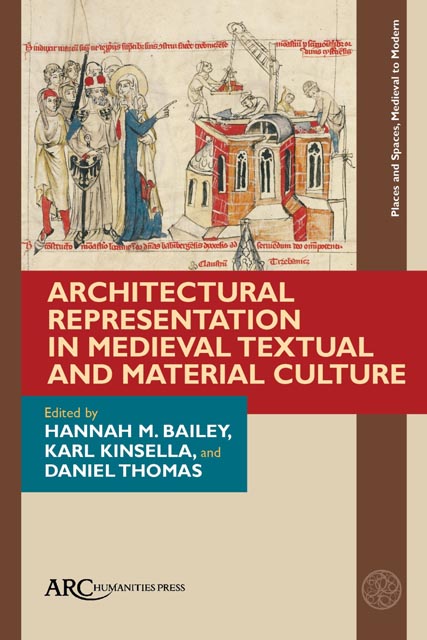Book contents
- Frontmatter
- Contents
- List of Illustrations
- Acknowledgements
- Introduction: Architectural Representation in Medieval Textual and Material Culture
- Chapter 1 Designing the Regensburg Spire and Harburg Tabernacle: The Geometries of Two Great German Gothic Drawings
- Chapter 2 Wilfrid’s Restoration of the Church at York and the Permanence of Sacred Buildings in Post-Conversion Northumbria
- Chapter 3 Heaven-Roofs and Holy Altars: Envisioning a Seventh-Century English Church in Aldhelm’s Carmina Ecclesiastica 3
- Chapter 4 “Beaten Down and Built Anew”: Saint Erkenwald and Old St. Paul’s
- Chapter 5 Castle Viewscapes in Literature and Landscapes
- Chapter 6 Architectural Alignment in Early Medieval English Settlements: Zoning, Meaning, and Function
- Chapter 7 Underneath the Arches: Peter of Eboli and the Orderly Architecture of Norman Sicily
- Chapter 8 Reading the Saint’s Church: A Northern Perspective
- Select Bibliography
- Index
Chapter 1 - Designing the Regensburg Spire and Harburg Tabernacle: The Geometries of Two Great German Gothic Drawings
Published online by Cambridge University Press: 16 November 2023
- Frontmatter
- Contents
- List of Illustrations
- Acknowledgements
- Introduction: Architectural Representation in Medieval Textual and Material Culture
- Chapter 1 Designing the Regensburg Spire and Harburg Tabernacle: The Geometries of Two Great German Gothic Drawings
- Chapter 2 Wilfrid’s Restoration of the Church at York and the Permanence of Sacred Buildings in Post-Conversion Northumbria
- Chapter 3 Heaven-Roofs and Holy Altars: Envisioning a Seventh-Century English Church in Aldhelm’s Carmina Ecclesiastica 3
- Chapter 4 “Beaten Down and Built Anew”: Saint Erkenwald and Old St. Paul’s
- Chapter 5 Castle Viewscapes in Literature and Landscapes
- Chapter 6 Architectural Alignment in Early Medieval English Settlements: Zoning, Meaning, and Function
- Chapter 7 Underneath the Arches: Peter of Eboli and the Orderly Architecture of Norman Sicily
- Chapter 8 Reading the Saint’s Church: A Northern Perspective
- Select Bibliography
- Index
Summary
Many of the most impressive architectural drawings produced in the Gothic era depict spired church towers or spire-like tabernacles. These two similarly shaped monument types differed in scale, but each had particular qualities that made them crucially important for Gothic designers and their patrons. Spires were the most prominent elements on the skylines of medieval cities, sometimes reaching well over 100m in height, and the more complicated ones typically shown in surviving drawings were extremely expensive, which meant that their construction required close administrative oversight. Finely executed drawings could be used to document the designs in question for the approval of the patrons, and they could even be used in fundraising initiatives. Importantly, too, spires were necessarily built from the bottom upwards, without the kind of horizontally repeating modular structure seen in the main bodies of their host churches. Drawings were thus essential tools for designers who wished to establish the overall format of spired towers that might not be completed in their lifetimes. The stakes in tabernacle design were also high, in their own way. Most of the tabernacles depicted in surviving drawings were intended to enshrine the consecrated host wafers that were considered to be the truly present body of Jesus, making them crucial devotional foci in a church interior. Although these shrines are often described as micro-architectural, they often reached impressive heights on the order of 15–20m, with the largest of them, in Ulm Minster, reaching 26m. This was certainly large enough to make a dramatic impression on any viewer, but small enough that considerations of structural stability and cost were less constraining than in the construction of full-scale spires. Designers thus had both the motivation and the means to indulge their wildest fantasies in the design of tabernacles, which became showpieces of their creative virtuosity. By the end of the Gothic era, therefore, tabernacle drawings had begun to reach a level of scale and sophistication that had previously been reserved for drawings of full-scale spires. The dialogue between these monument types was liveliest in the Germanic world, which preserves more Gothic drawings than any other region. This chapter uses geometrical analysis to shed light on two particularly spectacular drawings, one in each of these genres.
The first drawing, which has long been preserved in Regensburg, measures an impressive 4.42m high.
- Type
- Chapter
- Information
- Publisher: Amsterdam University PressPrint publication year: 2023



